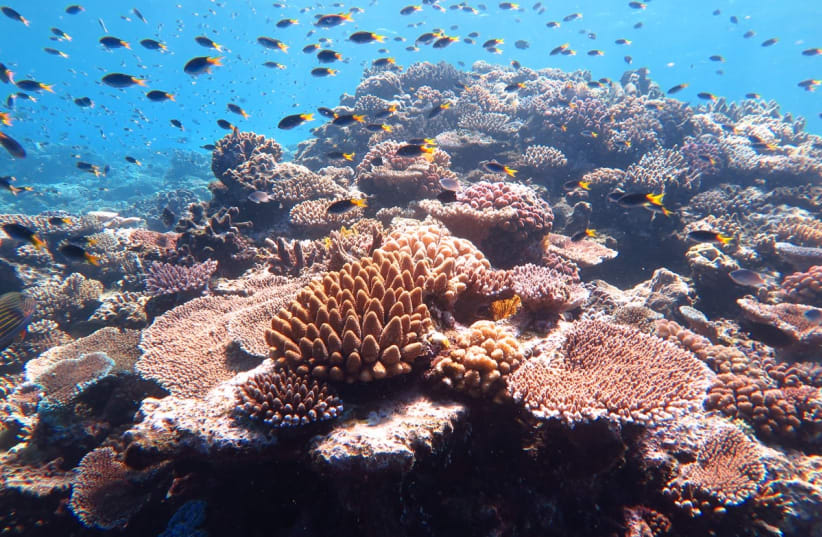Researchers found antibiotics and laxatives in corals at a depth of 40 meters – with Sulfamethoxazole being identified across 93% of the sampled corals.
By JUDY SIEGEL-ITZKOVICH. OCTOBER 5, 2024

Corals are invertebrate animals that eat plankton and belong to a large group of amazing colorful animals called Cnidaria (“stinging needles”). Living together as coral reefs, they protect coastlines from storms and erosion, provide jobs for local communities, are a source of food via fisheries and new medicines, attract tourists, and offer opportunities for recreation. Over half a billion people depend on the reefs, but humans are not kind to them.
Shockingly, significant amounts of more than 10 kinds of antibiotics and laxatives consumed by patients have been found in samples collected in Gulf of Eilat corals – not only in shallow waters at depths of five to 12 meters but also in deep waters at 30 to 40 meters down. Sulfamethoxazole, an antibiotic used for respiratory and urinary tract infections, was found in as many as 93% of the corals they tested.
The research, conducted at Tel Aviv University (TAU) and the Steinhardt Museum of Natural History, shows that human activity is polluting even remote marine environments. The alarming study was led by Prof. Noa Shenkar of TAU’s School of Zoology and her doctoral student Gal Navon, in collaboration with the hydrochemistry laboratory led by Prof. Dror Avisar at TAU’s Porter School of Environment and Earth Sciences.
Although pharmaceutically-active compounds (PhACs) are increasingly being found to be present in marine environments, their presence in coral reefs, already under threat from various stressors, had remained unexplored. The marine environment, particularly tropical coral reefs, constitutes a cornerstone of global biodiversity, supporting countless species and providing vital ecosystem services. But despite their ecological and socio-economic importance, coral reefs face mounting threats from human activities, including overfishing, invasive species introduction, and habitat pollution and destruction.

The results have just been published in the prestigious journal Environmental Pollution under the title “Detection of 10 commonly used pharmaceuticals in reef-building stony corals from shallow and deep sites in the Red Sea.”
Researching the coral
The research team took samples from 96 reef-building stony corals, some of which lay more than 30 meters below the ocean surface. The results were shocking – regardless of the depth, none of the coral samples was found to be free of drug residues. Coral reefs are in decline in the US and around the world, and many environmental scientists now believe the very existence of coral reefs may be at risk unless we intensify our efforts to protect them
“In this first-of-its-kind study, we conducted a large-scale investigation for detection of pharmaceuticals in corals,” said Shenkar. “We sampled reef-building stony corals representing two types, Acropora sp. and Favites sp. We were surprised to find an extensive presence of medications even in the deep-water corals that usually escape contaminations affecting corals in shallower areas.”
The researchers obtained a list of the most commonly used pharmaceuticals in Israel from the largest public health fund, Clalit Healthcare Services. Testing for 18 of these compounds, they detected 10 of them in the coral samples. Not even a single sample, retrieved from either shallow or deep water, was found to be drug-free. The 10 pharmaceuticals found in the corals belonged to different categories – , laxatives, proton pump inhibitors, statins, antidepressants, antibiotics, blood-pressure medications, antiplatelet agents, and calcium channel blockers.
Upon entering a marine environment, PhACs can persist, bioaccumulate, and exert various adverse effects on marine organisms, including altered physiological processes, impaired reproductive success, and increased susceptibility to disease
“What does the presence of pharmaceuticals in corals actually mean? Clearly, the corals did not receive a prescription for antibiotics from their doctor,” Shenkar said with irony.
“These medications are taken by humans to affect a certain receptor or biological pathway, and they can also impact other organisms. Previous studies, conducted by both our lab and others, have revealed many examples of this negative impact – estrogen from birth-control (contraceptive) pills induces female features in male fish, impairing reproduction in certain species; Prozac makes some crabs aggressive and reckless; and antidepressants damage the memory and learning abilities of squids. There is no reason to believe that corals should be immune to such effects. For instance, if our pharmaceuticals should disrupt the spawning synchrony of coral populations, it would take us a long time to notice the problem, and when we do, it might be too late.”
Clearly these medications save lives, and we have no intention of requesting people to reduce their use, Shenkar declared. “But we must develop new sewage-treatment methods that can effectively handle pharmaceutical compounds. Also, each of us must dispose of old medications in ways that do not harm the environment. Ultimately these drugs come back to us. I know people who avoid certain medications, but when they eat a fish, they might unknowingly consume a ‘cocktail’ of drug residues absorbed by the fish from the marine environment.”
“Stony corals build coral reefs, and the types we studied are very common in the Gulf of Eilat,” added Navon. “Coral reefs are a cornerstone of marine biodiversity. They provide food, shelter, and spawning sites to numerous species and support the human fishing and tourism industries. Today this delicate ecosystem is under pressure as a result of climate change, pollution, and overfishing. The presence of pharmaceuticals in coral tissues adds another layer of concern, indicating that human activities even contaminate faraway marine environments. The detection of 10 different PhACs in coral tissues underscores the urgent need for conservation efforts to mitigate contamination from humans in coral reef ecosystems. These findings highlight the vulnerability of coral reefs to pharmaceutical pollution.
The Environment and Climate Change portal is produced in cooperation with the Goldman Sonnenfeldt School of Sustainability and Climate Change at Ben-Gurion University of the Negev. The Jerusalem Post maintains all editorial decisions related to the content.

Pioneering climate solutions >
“These medications are taken by humans to affect a certain receptor or biological pathway, and they can also impact other organisms. Previous studies, conducted by both our lab and others, have revealed many examples of this negative impact – estrogen from birth-control (contraceptive) pills induces female features in male fish, impairing reproduction in certain species; Prozac makes some crabs aggressive and reckless; and antidepressants damage the memory and learning abilities of squids. There is no reason to believe that corals should be immune to such effects. For instance, if our pharmaceuticals should disrupt the spawning synchrony of coral populations, it would take us a long time to notice the problem, and when we do, it might be too late.”
Clearly these medications save lives, and we have no intention of requesting people to reduce their use, Shenkar declared. “But we must develop new sewage-treatment methods that can effectively handle pharmaceutical compounds. Also, each of us must dispose of old medications in ways that do not harm the environment. Ultimately these drugs come back to us. I know people who avoid certain medications, but when they eat a fish, they might unknowingly consume a ‘cocktail’ of drug residues absorbed by the fish from the marine environment.”
“Stony corals build coral reefs, and the types we studied are very common in the Gulf of Eilat,” added Navon. “Coral reefs are a cornerstone of marine biodiversity. They provide food, shelter, and spawning sites to numerous species and support the human fishing and tourism industries. Today this delicate ecosystem is under pressure as a result of climate change, pollution, and overfishing. The presence of pharmaceuticals in coral tissues adds another layer of concern, indicating that human activities even contaminate faraway marine environments. The detection of 10 different PhACs in coral tissues underscores the urgent need for conservation efforts to mitigate contamination from humans in coral reef ecosystems. These findings highlight the vulnerability of coral reefs to pharmaceutical pollution.
The Environment and Climate Change portal is produced in cooperation with the Goldman Sonnenfeldt School of Sustainability and Climate Change at Ben-Gurion University of the Negev. The Jerusalem Post maintains all editorial decisions related to the content.

Pioneering climate solutions >
https://www.jpost.com/environment-and-climate-change/article-823227
